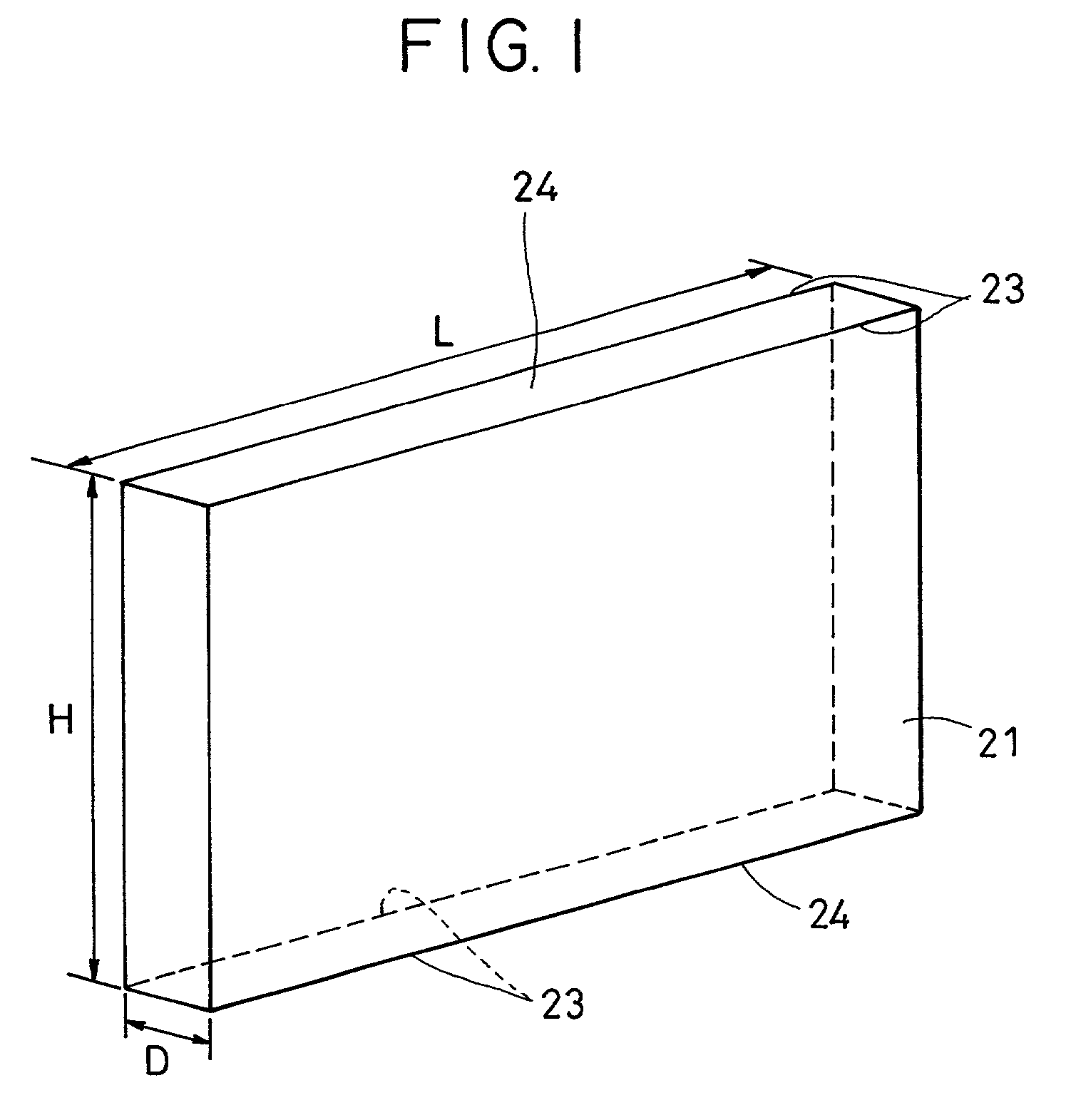Method of producing spacer and method of manufacturing image forming apparatus
a technology of image forming apparatus and spacer, which is applied in the manufacture of electrode systems, electrode assembly, electric discharge tube/lamps, etc., can solve the problems of less heat-melting of substrates, distorted images, and fear of creeping discharge on the surface of spacers
- Summary
- Abstract
- Description
- Claims
- Application Information
AI Technical Summary
Problems solved by technology
Method used
Image
Examples
example 1
[0286] The spacer 20 used in example 1 was formed as described below. The procedure for the substrate shaping step, the mask layer forming step, the bundling step, the mask layer patterning step, low-resistance film forming step and the mask layer removing step was the same as show in FIG. 2B. FIG. 30 schematically shows spacer base materials and substrates in each of the steps in this procedure.
[0287] A soda lime glass plate comprising the same material as the faceplate and rear plate was used as a spacer base material, and subjected to the heat drawing process shown in FIG. 13 to obtain the spacer base member 21 having the sectional shape shown in FIGS. 9B and 10B. FIG. 10 is an enlarged sectional view of one of the ends near the contact portions shown in FIG. 9.
[0288] The thus-obtained spacer base member 21 was used as the spacer 20. The spacer base member 21 formed in this example had a height H of 3 mm, a thickness D of 0.2 mm, a length L of 650 mm, as shown in FIG. 1. The glas...
example 2
[0305] The spacer 20 used in this example was produced as described above. The method of patterning the low-resistance film of the spacer base member 21 was performed according to the procedure for the substrate shaping step, the mask layer forming step, the bundling step, the mask layer patterning step, the low-resistance film forming step, and the mask layer removing step shown in FIG. 3B. FIG. 31A to G show the appearance of a substrate in the respective forming steps. The same substrate shaping step and the same forming method as Example 1 were repeated except that the bundling step was performed after the mask layer pattering step to form the low-resistance film (electrode) 25 on the end surfaces (contact surfaces) of the spacer base member 21.
[0306] Furthermore, the high-resistance film 22 was formed by the same sputtering method as Example 1 to form the spacer 20.
[0307] In each of the thus-obtained spacers 20, the low-resistance film (electrode) 25 had light reflection, the s...
example 3
[0309] The spacer 20 used in this example was produced as described below. The low-resistance film (electrode) 25 was formed by the same method as Example 1 except that a plate-shaped spacer base member 21 having contact portions each having the shape shown in FIG. 9 and 10, and an uneven stripe structure in the longitudinal direction was used in place of the spacer base member 21 formed in Example 1. Also, the bundling step was performed by the same method as Example 1 before the mask layer pattering step after the formation of the mask layer. In this step, the bundle state is shown on the left side of FIG. 5A (not showing the coated mask layer). In this state, spaces occurred near the contact portions. Then, the high-resistance film 22 was formed by sputtering in the same manner as Example 1 to produce the spacer 20.
[0310] In each of the thus-obtained spacers 20, the low-resistance film (electrode) 25 had light reflection, the shape with good linearity, and neither projection to t...
PUM
| Property | Measurement | Unit |
|---|---|---|
| Electrical resistance | aaaaa | aaaaa |
| Sheet resistance | aaaaa | aaaaa |
Abstract
Description
Claims
Application Information
 Login to View More
Login to View More - R&D
- Intellectual Property
- Life Sciences
- Materials
- Tech Scout
- Unparalleled Data Quality
- Higher Quality Content
- 60% Fewer Hallucinations
Browse by: Latest US Patents, China's latest patents, Technical Efficacy Thesaurus, Application Domain, Technology Topic, Popular Technical Reports.
© 2025 PatSnap. All rights reserved.Legal|Privacy policy|Modern Slavery Act Transparency Statement|Sitemap|About US| Contact US: help@patsnap.com



